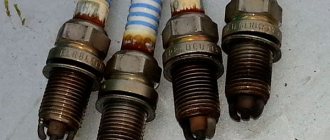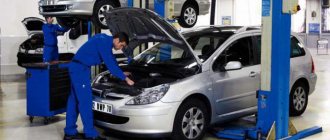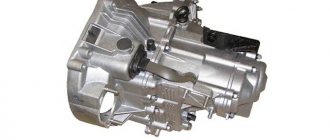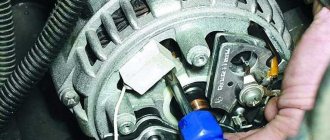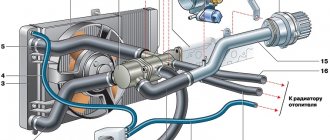Question No. 1: why is the car air filter covered in oil and the reasons for this phenomenon?
This question arises among some car enthusiasts during the next air filter replacement; moreover, this fact causes confusion among many. According to their opinion, there can be no connection between the lubrication and air filtration systems of internal combustion engines. However, even minimal knowledge of the principles of operation of the power unit makes it possible to refute this concept.
In fact, the answer to the riddle of why the air filter is in oil is simple - in addition to the main air flow, crankcase gases also pass through the filter element. Moreover, their concentration is directly proportional to engine wear. Serious problems with the cylinder-piston group lead to the penetration of lubricating fluid into the crankcase and the appearance of excess pressure, which destroys the seals. All these factors contribute to unwanted penetration of lubricant into the air filter.
Based on the experience of practicing craftsmen, we can outline the most common reasons why oil ends up in the filter element:
- High levels of wear and coking of the piston rings, which does not allow excess lubricant to be effectively removed from the cylinder walls, and the substance penetrates into the crankcase.
- The oil deflector drain is clogged and the remaining lubricant cannot return to the crankcase, so the air filter is filled with oil supplied with crankcase gases.
- Clogged crankcase gas throttle outlet hose.
- The filter element loses its performance characteristics; in other words, the air filter becomes contaminated with dust. Due to the insufficient volume of incoming air, the engine begins to compensate for this parameter by suction from the crankcase.
Preventive actions
You can prevent the appearance of oily stains on the air filter by following these recommendations:
- when operating the car, use high quality oil recommended for this brand;
- expensive, proven gasoline is used, this will extend the life of the engine;
- It is necessary to periodically inspect the air filtration system and change components based on the recommended service life. If the technical specifications say that the filter will need to be replaced after 15 thousand km, they do it 2-3 thousand km earlier. Some drivers have no idea that the filtration system is very important. They do not look at the condition of the filter, which jeopardizes the performance of the engine.
Can I drive until the problem is fixed?
If oil is detected on the filter, stop driving the car and carry out diagnostic measures. Ignoring the problem for a long time will increase the cost of repairs.
Let's find out the reasons why engine oil gets into the car's air filter?
First of all, you need to understand that the detection of even minimal traces of lubricating fluid in the air purification device indicates a malfunction in the operation of the power unit. This fact cannot be ignored, because in the end such irresponsibility ends in expensive repairs. Experienced car enthusiasts recommend immediately performing several simple operations to determine the reasons for lubricant getting into the air filter:
- Check the compression level in each cylinder. Indicators that range from 9 to 12 atmospheres are considered normal. Deviations in numbers between cylinders should be no more than 1 atmosphere. If the compression does not meet the minimum parameters, then this is a direct indication of problems with the engine.
- Assess the color of the smoke from the exhaust pipe. A black or blue tint indicates wear of the elements of the cylinder-piston group.
If the compression readings are normal and the color of the smoke does not raise suspicions, then you can relax a little - the troubles are not so serious. The most likely reasons why oil gets into the air filter is that it is clogged or the hoses with channels through which crankcase gases are discharged are obstructed.
Solving the problem is not particularly difficult - just replace the filter element, clean or replace the hoses. For complex cases, a temporary resolution of the issue is also possible, which still does not cancel serious repairs.
If your car's air filter is filled with oil: a quick way out
Such a way out of the situation, of course, will not completely eliminate the entry of lubricating fluid into the air filter, but it does provide the opportunity to operate the car for some time. To do this you need to perform the following operations:
- disconnect the hose that supplies crankcase gases from the filter fitting;
- close the fitting;
- connect a longer hose to the crankcase ventilation so that its lower end is located below the engine level.
Compression check
After checking the compression, you can breathe a sigh of relief or worry, since the cost of the repair depends on the result.
Impaired compression often causes the presence of oil in the VF, and also causes a number of other problems.
Compression check
To work you will need:
- Compressometer;
- A rag in oil, which you will use to determine the compression stroke;
- Adapter for spark plug holes. It is used when checking the combustion chamber for leaks;
- Compressor.
Now let's start checking.
- Warm up the engine to operating temperature, then turn off the fuel supply.
- In the case of a carburetor, you need to remove the hose, clamp or squeeze it with something, or lower it into a container.
- If you have an injector, remove the fuel pump fuse, start the engine and let it run. As soon as the fuel in the fuel rail runs out, it will stall on its own.
- Disconnect the ignition system by removing the center wire from the distributor (on the carburetor). The crankshaft position sensor at the injector must be disconnected.
- Remove all debris from the spark plug wells so that it does not end up inside the cylinders. Unscrew the spark plugs.
- Insert the compression gauge fitting while an assistant starts the engine. The starter should rotate the engine until the pressure gauge needle stops in one position.
- By analogy, measurements are carried out on each cylinder, the results are recorded on paper.
- To calculate ideal compression, use the formula - 1.2 * Compression ratio.
See your owner's manual for the compression ratio of your engine. Please also note that measurements may have some error.
What you need to know about verification
- If the indicator is 12 atmospheres, this indicates that your engine is almost in perfect condition.
- When checking the compression on a cold engine, the compression readings will be significantly lower. Perform the test only on the engine at operating temperature.
- If the battery is partially discharged, the test data will also not be accurate.
- The increase in compression occurs due to the combustion of oil in the cylinders.
What the results say
We take the paper where you wrote down the data of the check, carried out according to all the rules, and study what is wrong with the motor.
- Indicators in the range of 0-4 atm indicate a high probability of burnout of the piston, head gasket or valve.
- Compression of 4-6 atmospheres indicates that the piston rings or the partition between them have broken.
- If you get about 8-10 atm in each cylinder, the cylinder-piston group is worn out. Major repairs will soon have to be carried out.
- 12-12.5 atm - these are the indicators that occur in a new, run-in power unit.
- If the car has serious mileage, and the check data shows numbers equal to or exceeding the norm, oil has probably entered the cylinders due to wear of the cylinder-piston group or valve liners.
Obviously, the presence of oil in the filter does not bode well. But the problem can still be prevented if measures are taken in time.
Loading …
Briefly about the prevention of ICE
In conclusion, we will consider some aspects of preventive measures designed to prevent the moment when the car’s air filter fills with oil due to defects in the cylinder-piston group. Their essence lies in the following points:
- Change the lubricant more often; if the manufacturer recommends, for example, changing it after 15,000 km, then you do not need to maintain this particular interval - it is better to change it after 10,000 km. The fact is that the timing depends on many parameters, including seasonality, operating conditions, and the quality of fuels and lubricants.
- Purchase only certified lubricants.
- Be sure to combine an oil change with the installation of new air and oil filters.
- Use only high-quality fuel from proven brands.
These simple rules will improve the performance of the motor and also increase its service life. It would not be superfluous to install a universal oil catcher on the crankcase gas supply tube. Its price is low, but the effect of its use will not be long in coming - the filter element will be reliably protected from lubricant penetration.
The air filter is an important consumable component that protects key engine components from dirt, dust, stones, insects and other debris that can harm the stable operation of the engine. The air filter should be changed every 10-15 thousand kilometers, or in accordance with the manufacturer's recommendations.
When replacing, the driver may encounter the problem that traces of engine oil appear on the filter element. In some situations, the driver pays attention to this due to symptoms of improper operation of the air filter, which has not yet completed its required mileage. It is prohibited to operate a filter that contains traces of engine oil for reasons of safety of the car engine. At the same time, installing a new filter element will not get rid of the problem, since after a few kilometers of run oil traces will appear on it. Before changing an air filter that has traces of oil on it, you should find the problem and fix it.
Symptoms of a malfunctioning crankcase ventilation system
- the smell of burnt oil in the car interior when the engine is running;
- increased fuel and oil consumption;
- traces of oil on the body and breather pipe outside or near them;
- smoke from the oil filler neck when unscrewing the cap;
- clogging of carburetor jets, oiling of the air filter housing, throttle body and the insides of the intake manifold;
- squeezing out oil through gaskets, seals, and dipstick hole.
Some car owners, faced with the problem of oil escaping through the breather, disconnect its pipe from the inlet or filter housing and turn it down. This doesn't fix
the root cause of the problem, but only prevents oil from entering the intake, carburetor and throttle valve.
In addition, toxic crankcase gases
will partially end up in the car interior.
Why does oil get into the air filter?
Engine oil in the air filter is a serious problem, which indicates the presence of damage to key engine elements, or their malfunction for one reason or another. If oil gets into the air filter, it most often happens for the following reasons:
- The oil deflector drain is clogged, which is why residual oil cannot return to the crankcase, and it will exit through the air filter along with crankcase gases;
- Piston rings are stuck, damaged or worn. This will prevent the rings from properly collecting excess oil that will begin to leak into the crankcase. Accordingly, dirty oil will begin to be squeezed out through the oil deflector and valves intended for ventilation;
If the driver has not changed the air filter for a long time, you should first make sure that the problem is not related to it. To do this, you will need to install a new filter element, drive several kilometers, and then examine it for oil stains. If oil continues to get into the air filter, more thorough engine diagnostics will be required to determine the cause.
A spoon is good for lunch
You need to take care of your car no less than your girlfriend, if not more. Therefore, it is always better to prevent serious breakdowns in a timely manner. To begin with, change all necessary consumables on time. Including filters. Including air. When replacing, you should carefully inspect the “protection” of the engine. Without paying attention to the presence of foreign liquid in it, you may not eliminate the problem at its root. But overhauling an engine is not a cheap pleasure. Therefore, it is better to immediately fix what can still be fixed without destroying your beloved motor. Prevention, of course, is cheaper than repair, and therefore it is worth paying attention to the work of your swallow. And still measure compression from time to time.
Motorists rarely look into the air filter and often find out that oil particles have entered only during a planned or emergency replacement of this element. However, if oil is found in the air filter, the owner needs to find the cause and fix the problem.
Oil can also accumulate in the corrugation leading to the filter.
Can you drive your car if oil gets into the air filter?
If the driver aims to delay engine overhaul as much as possible, then it is necessary to quickly respond to such serious problems as engine oil getting into the air filter. In such a situation, it is necessary to identify the cause of the problem as quickly as possible and eliminate it, since the malfunction can be very serious.
If there is no way to fix the problem at a particular time, and the machine needs to be operated, you can temporarily prevent oil from getting into the air filter. To do this, you will need to disconnect the hose from the filter fitting, which removes gases from it. Next, the fitting is sealed, and the crankcase ventilation is removed using a longer hose below the engine.
Important: This solution to the problem is temporary, and it can be used to drive the car to a service center for full diagnostics and repairs.
Cleaning the throttle body
If it was not possible to pierce the tube with wire, you need to completely dismantle the throttle valve. This is done as follows:
- the pipes approaching the damper from above are removed;
- the latch is removed and the cable controlling the gas is removed;
- the electronic throttle position sensor is disconnected;
- unscrew 2 13 nuts securing the damper (one higher, the other lower).
The throttle valve is easily removed from the engine block, after which it needs to be cleaned. This does not require additional equipment and tools; all work can be done in a regular garage.
To clean the throttle valve, we take the same wire with a diameter of 0.8 mm and clean the tube from the reverse side. We periodically use a cleaning aerosol that will help wash away any remaining carbon deposits and other debris from the pipe. You can use a liquid lubricant like WD-40, which also removes carbon deposits and other contaminants well. After this, the pipe is purged again, and if air passes through it, the throttle valve is replaced and engine oil will no longer appear in the air filter.
When assembling the air filter, you need to thoroughly clean the corrugation so that there are no oil stains left on it. If the filter itself becomes dirty, it is better to replace it, otherwise the air supply to the engine will be difficult, which will negatively affect its operation. After this, the car can be operated normally.
To check the effectiveness of the repair, after a month it is advisable to remove the air filter bellows and carefully inspect it. There should be no oil drips or splashes in its opening. If they appear, you need to clean the throttle tube again using one of the proposed methods. But recurrence of the problem after a month of operation is rare.
Video: oil in the air filter and bellows, cause and solution
What to do to prevent oil from getting into the air filter
The problem with oil getting into the air filter is typical for older engines that have traveled more than 150-200 thousand kilometers. To delay as much as possible the moment when engine oil begins to enter the filter element, it is recommended to properly monitor the engine:
Buy high-quality oil recommended by the car manufacturer. Remember that motor oil from major brands is often counterfeited, so you should purchase the fluid from reputable stores;
High-quality consumables are the key to the “health” of the engine. It is better not to skimp on oil, gasoline and filters so that the need for major engine repairs does not appear too early.
A part such as a car air filter performs a very important function. It serves to clean the air entering the engine, necessary for the formation of the fuel mixture, from various pollutants (litter, sand and other abrasive particles). If air that has not undergone such purification enters the engine, the cylinder walls may be subject to rapid wear, and the engine itself will ultimately fail.
It is to transfer such purified air from the filter to the engine that the VAZ 2114 air filter pipe, which has the form of a corrugated channel of complex shape, is used.
The most common type of damage to this part is mechanical, most often ruptures of the outer shell. Their reasons are simple and understandable, but sometimes troubles arise that make the car enthusiast much more worried - such as oil getting into the filter bellows.
Replacement frequency
To fully understand the need to replace the Priora air filter, let's imagine a situation: the filter is so clogged that it passes only half the required volume of air required for fuel combustion. What happens in the cylinders when the mixture is ignited?
An incorrectly prepared air-fuel mixture will not burn completely, because complete combustion of a certain amount of gasoline requires an appropriate volume of air. In this case, a considerable portion of the fuel will simply fly out into the chimney, and, accordingly, the engine will lose power.
The price of a Priora air filter is not so high that it would be so wasteful to waste expensive gasoline. It’s easier to replace the part and enjoy the efficiency of this car. The manufacturer recommends changing the air filter of the Lada Priora every 30 thousand kilometers.
However, many car enthusiasts replace the filter element much more often. And it is right. Agree that driving through a relatively clean city and dusty country roads are completely different conditions in terms of the load on the filter element.
That is why you need to decide for yourself when to replace the air filter of the VAZ 2170 Priora. Dusty and dirty roads, poplar fluff - all this should speed up the replacement process much more. If your car only goes on stage at a local theater as a prop, then perhaps you can listen to AvtoVAZ’s recommendations. Do you use your Lada in other conditions? Then change the filter at least every 15 thousand km.
Eliminating the causes of oil condensation in the pipe
The very first thing to do when this problem occurs is to check the oil level. If it is higher than normal, then the excess should be drained immediately. After this, its level should be between the minimum and maximum marks on the oil dipstick.
If after adjusting the oil level (or if it was not needed at all) the problem remains, then the crankcase ventilation ducts should be cleaned. This is very simple to do - just start the car and let it idle for half an hour or a little more. This is usually enough to restore normal operation of the ventilation ducts.
For preventive purposes, it is recommended that every day you intend to use the machine, let it first idle for a while. This will help completely get rid of the problem of clogging of the crankcase ventilation ducts.
If it was not possible to clean the channels at idle speed, and they are really seriously clogged with carbon deposits, you will have to clean them manually. It is best to do this in a car service center or with special equipment, since for complete cleaning you will have to disassemble the engine itself.
Another common reason for which there is oil in the air filter pipe of the VAZ 2114 and which you can fix yourself is a damaged air filter. It can be either worn out (with signs of destruction) or heavily soiled.
In any case, its damage leads to difficulty in the passage of air flow, and this, in turn, leads to an increase in pressure and oil emissions from the crankcase. In order to eliminate this reason, you just need to replace the air filter with a new one.
Sometimes, although quite rarely, the reason for the appearance of oil in the corrugation is the oil itself (for example, low quality). Therefore, if the car’s engine is in good working order, and all other attempts to eliminate oil getting into the pipe have not helped, then it is worth trying to completely replace the engine oil with a product of a different brand.
If all of the above methods did not have the desired effect, then you should think about the most unpleasant option - wear and tear on the elements of the engine itself. This (besides oil ingress) may be indicated by the following signs:
- Difficulty starting.
- A sharp drop in power.
- Black exhaust smoke.
- Unstable operation at idle.
- Compression loss in cylinders.
If the car exhibits at least one of these signs, you should stop using it and contact a car service center for a complete engine diagnosis.
Pressure reducing valve
In most cases, if the oil is in order and there are no complaints about the filter, it turns out to be the culprit. We considered this option in paragraph 5 (bypass and pressure reducing valves are the same thing). If he turns out to be the culprit, then the visit to the service station can be postponed: checking and replacing it is available for independent execution. All you need is a set of keys and old rags.
- The timing belt cover is removed;
- The plug is unscrewed from the bypass valve;
- The spring is removed from the socket. It is responsible for the operation of the valve, and its integrity ensures the release of excess pressure;
- The spring is carefully examined. There should be no nicks or other damage on it. Creases and kinks are also not allowed;
- The coils should be tight; If the spring can be easily stretched with your fingers, metal fatigue is evident. The height of the element must be strictly 44.72 mm. A lower value indicates that part of the spring has been broken off for some reason. In this case, take the trouble to remove the fragment from the nest so that it does not spoil your picture in the future. If the spring does not meet specifications, it should be replaced.
In principle, there are no other reasons in nature why oil squeezes out and flows from under the oil filter. If the bypass valve is in order, the filter is installed correctly, the seal is lubricated and intact, and the oil continues to press through, think about changing the manufacturer of the filter element: most often this is due to poor quality.
Signs of excessive filter clogging are an over-enrichment of the fuel mixture due to poor air permeability of the filter. When removing the filter from a running engine, the speed increases (the permeability is already poor, the membrane is clogged). The first sign is the appearance of the air filter; if it is dirty, dusty, or the pores are clogged, then it needs to be changed urgently. The second sign is changes in engine operation: the engine begins to operate unstably at idle, engine power drops, and excess fuel consumption appears.
Do I need to replace a worn or damaged pipe?
Some motorists believe that you can drive with a cracked pipe, but this position is fundamentally wrong. Firstly, a damaged pipe will not be able to supply clean air to the engine. After all, through the gap, air from under the hood will enter it, which has not been filtered, and therefore carries abrasive particles (which, as mentioned, can quickly damage the engine).
Secondly, driving with a damaged corrugation also leads to faster wear of the air filter; it will have to be changed much more often. That is why a damaged or worn pipe should be immediately replaced with a new one.


